 ?Mathematical formulae have been encoded as MathML and are displayed in this HTML version using MathJax in order to improve their display. Uncheck the box to turn MathJax off. This feature requires Javascript. Click on a formula to zoom.
?Mathematical formulae have been encoded as MathML and are displayed in this HTML version using MathJax in order to improve their display. Uncheck the box to turn MathJax off. This feature requires Javascript. Click on a formula to zoom.ABSTRACT
Solid-state nuclear magnetic resonance, which enables the characterization of structures of a variety of materials whatever their crystallinity/amorphous state, is used in the present work to determine the provenance of two raw materials, namely marbles and cherts. Regarding marbles, the 13C NMR signal of the carbonate function contains information about both the Fe content in its area and the presence of calcium substitutions in the calcite crystal in its linewidth. Regarding cherts, discriminant information is provided by both 29Si and 27Al NMR: the 29Si area signal depends on the paramagnetic ion content of the material, and the 27Al spectra give information both on the aluminosilicate content and its distribution in tecto- and layer-lattice aluminosilicates. As an application, we use the differences observed from one source to another to determine the provenance of archaeological finds.
GRAPHICAL ABSTRACT
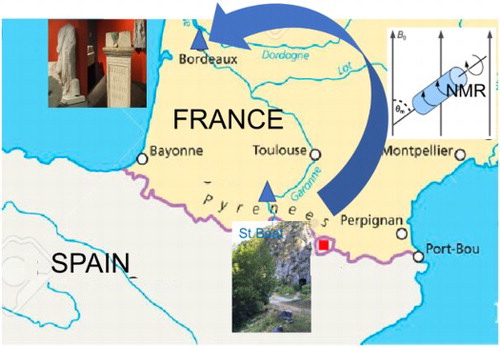
KEYWORDS:
Introduction
Determining the geographical origin of the raw materials used for precious artefacts such as prehistoric tools and ancient monuments/statues is a challenge that allows to get an essential insight to historical aspects of past societies. The analyst looks for some clues, up to traces of some minerals, crystalline phases, fossils while applying more and more statistical tools to analyse the data collected. The aim of the present work was to identify the provenance of two kinds of stone used at very different periods for different purposes: chert tools from the Magdalenian, and marbles, symbols of power and luxury whose prestige reached its apogee during the reign of the emperor Augustus (63 BC–14 AC). In this goal, we used a methodological approach combining traditional analysis methods with Nuclear Magnetic Resonance (NMR). NMR has many advantages for the study of archaeomaterials: it is a non-destructive and versatile technique since it allows to probe the raw material without any previous preparation. While some NMR applications are able to be used in a non-invasive way without any sampling, using portable NMR instruments (mobile NMR), they are currently limited to detect the most sensitive nucleus, 1H, in a liquid state (Baias and Blümich Citation2018). Alternatively, Solid State NMR spectroscopy permits to obtain detailed structural information of inorganic materials down to a few milligrams of powder, in a non-destructive way since the radiation used for this kind of spectroscopy is non-ionising (Stebbins and Xue Citation2014) making the collected samples available for further analyses. It also provides invaluable chemical information which cannot be obtained with other techniques since all nuclei of the periodic table having at least one NMR-active isotope can be analysed, their respective sensitivities being linked to both the natural abundancy of the isotope chosen and its frequency resonance.
The first applications of NMR in the field of Cultural Heritage started less than 10 years ago, and were described in a review (Capitani, Di Tullio, and Proietti Citation2012), special issue (Capitani and Proietti Citation2015) and even book chapter (Webb Citation2018), showing that NMR is a very promising technology capable of investigating liquid, solid or even swollen samples by following isotopes with a non-zero nuclear spin of many different elements (Abragam Citation1961). Thus, NMR offers a very wide array of techniques for studying the structure and dynamics of organic or inorganic materials. For example, spectra of minerals were recorded soon after NMR development in the late 1940 s, and the progress observed for this technique has advantageously contributed to the Earth Sciences domain (Mackenzie and Smith Citation2002). Probably more than other spectroscopic methods, NMR gives information on the immediate structural surrounding through the chemical shift values of the resonances observed in the spectrum, on the number of atoms involved in the different resonances through the signal area when the relaxation conditions are respected and the presence of defects in the component observed thanks to the breadth at half-height of the resonance (Engelhardt Citation1989). At last, the spin–lattice T1 relaxation process can vary in proportion of the paramagnetic impurities content present in natural materials (Goldman Citation2001) and can be estimated when spectra are recorded under saturation conditions.
Regarding marbles, the target was their major component, calcium carbonate, whose NMR signal response depends on its local environment, such as the presence of secondary elements (Gutiérrez et al. Citation2019), and its crystallisation state (dolomite vs. calcite) (Pianet et al. Citation2018). The Carbon nuclide 13C, which is the NMR detectable isotope present at 1% naturally, was targeted. Its signal contains information about both the Fe content in its area and the presence of calcium substitution in the calcite crystal in its linewidth. In a previous work, we successfully used 13C solid-state NMR for white marble provenance, and we were able to distinguish between fine-grained white marbles coming from quarries located in six different countries (France, Italy, Spain, Portugal, Turkey and Greece) and to use the NMR spectrum profile to identify the origin of some archaeologic items (Gutiérrez et al. Citation2019). In the present work, we focus our analysis on marbles from the district of Saint-Béat (Région Occitanie, Département Haute-Garonne, Pyrénées, France) and try to localize the origin of the marble used for two archaeological items from the Musée d’Aquitaine collection (Bordeaux, Région Aquitaine, Département de la Gironde, France).
Cherts are mainly composed of silicate, and to a lesser extent of aluminosilicate. Thus, the nuclides commonly amenable to NMR measurements for this kind of mineral are 29Si (natural abundance, 4%) and 27Al NMR (natural abundance 100%) (Jakobsen, Jakobsen, and Lindgreen Citation1988). In the present work, solid-state NMR is used to get information in chert chemical structure, and to see if differences are observed depending on their geographic location. For this purpose, chert was collected from three different deposits of the Pyrénées (France), Montgaillard, Montsaunès and Buala (Sànchez de la Torre, Le Bourdonnec, and Gratuze Citation2019) and their 29Si and 27Al spectra compared with two archaeologic artefacts found in two different places (Montlléo –Prats i Sansor, Cerdanya, Spain- and Cova del Parco –Alòs de Balaguer, La Noguera, Spain) (Sànchez de la Torre Citation2015), and their provenances were successfully confirmed.
For the two kinds of lithic materials, marbles and cherts, studied herein, NMR spectroscopy has been successfully used as a tool for supporting decision-making for provenance identification.
Materials and methods
Samples
For marbles, white marbles were collected from four different quarries in the district of Saint-Béat: Boutx, Marignac, Saint-Béat Lavigne and Saint-Béat Château (see for their location). Samples were taken off two artefacts from the Musée d’Aquitaine collection for analyses purposes: a togatus (inventory number 60.2.19) and an altar dedicated to the Tutela Augusta (inventory number 60.1.20, ILA 17), both of them found at Bordeaux (Roman Burdigala).
Figure 1. Location of the marble quarries in the district of Saint-Béat (Département Haute Garonne, Région Occitanie, France). Left: the black insert localizes the district of interest; Right: expansion of the geographical area.
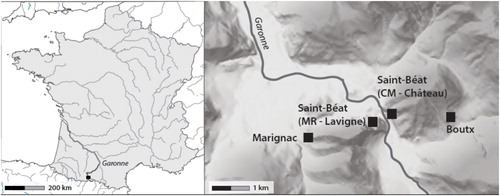
For cherts, experiments were performed on geologic samples from three distinct sources from the Pyrénées (Montgaillard, Montsaunès and Buala) and samples were taken from two archaeologic items found in the Palaeolithic sites of Montlleó and Cova del Parco.
Solid state NMR experiments
NMR experiments were recorded on a Bruker Avance II 400 (magnetic field of 9.4 T) equipped with a 4 mm CP-MAS probe (CESAMO facilities, Bordeaux, France).
For marbles, 13C MAS NMR spectra were recorded on 200 mg powdered samples at 100.6 MHz (9.4 T) and a spinning rate of 8 kHz; Single pulse-MAS spectra were collected with a recycling delay of 300 s, 32 transients and 2 dummy scans for a total experimental time of 170 min per sample.
For cherts, around 170 mg of powdered samples were used to record (i) 29Si at 79.51 MHz (9.4 T) and a rotation rate of 8 kHz, using a single pulse sequence with a recycling delay of 50 s and 256 transients for a total experiment time of 4 h, a Cross-Polarization pulse sequence using a contact time of 6 ms, a recycling delay of 5 s and 6000 transients for a total experiment time of 10 h and (ii) 27Al at 104.3 MHz (9.4 T) and a rotation rate of 10 kHz, or 3 kHz using a single pulse experiment with a recycling delay of 0.5 s and 5120 transients for a total experiment time of 45 min.
Spectra were analysed using the NMR solid state fitting process (sola) of the Topspin 3.5, pl7 software (BrukerTM).
Results
Marbles
In a previous paper (Gutiérrez et al. Citation2019), we demonstrated how 13C NMR was useful to determine the provenance of some archaeologic items: the target is the principal component of marble, calcite, whose 13C NMR signal presents a specific profile (area and full width at half maximum, ) depending on its provenance. In this previous work, we demonstrated that the area depends on the iron content, when the linewidth reflects defects in the calcite crystal in which the calcium is replaced by another atom such as aluminium, strontium or magnesium. Thus, by combining different geochemical methodologies such as ICP-OES, XRD and NMR, with common petrological techniques for the marbles considered (Gutiérrez Citation2011; Lapuente Mercadal Citation2014; Gutiérrez et al. Citation2016; Royo Plumed Citation2016) we were able to distinguish the marbles depending on their geological source. Also in the present work, focused on the contribution of solid-state NMR as a “decision-making” technique, we extend this analysis to marbles coming from the same region, the district of Saint-Béat (region Occitanie, France, ), for which further analyses are still under investigation (notably ICP-OES and DRX). presents 13C NMR spectra recorded for four different quarries around the town of Saint Béat: Boutx, Marignac, Lavigne (Saint-Béat, Mont Rié) and Château (Saint-Béat, Cap du Mont). displays the area and linewidth measured for the white marbles obtained in the previously mentioned quarries. Some interesting differences can be outlined, and were used to determine the geographic origin of the two artefacts from the Musée d’Aquitaine of Bordeaux, whose petrographic, cathodoluminescence and 13C/18O isotope signature features are characteristic of marbles coming from this region of the Pyrénées (Royo Plumed et al. Citation2015; Royo Plumed et al. Citation2018).Footnote1 The comparison of the 13C spectrum of these artefacts with the different marbles from the district of Saint-Béat permits to propose that they could be made of marble of the quarry Saint-Béat Château ().
Figure 2. 13C NMR spectra of white marbles from different quarries in the district of Saint-Béat: quarry "Château" in the Cap de Mont (CM-Château, purple); quarry "Lavigne" in the Mont-Rié (MR-Lavigne, green); quarry "Marignac" (grey); quarry "Boutx" (black).
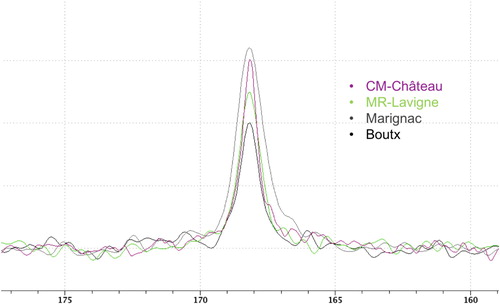
Figure 3. 13C NMR spectra of the altar dedicated to the Tutele Augusta (left, 60.1.20) and of a togatus (right, 60.2.19) in black compared with a spectrum of saint-Béat, from the quarry Château, in grey.
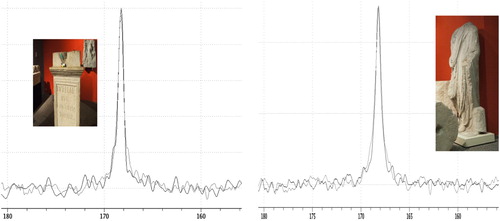
Table 1. Area and full width at half maximum of the 13C resonance of marbles from different geographic origins.
Cherts
Considering the success of solid-state NMR for decision-making purpose concerning marbles provenance, we use a similar strategy for cherts. In the present case, 29Si and 27Al magic-angle-spinning (MAS) NMR experiments are used for the identification of the silicate minerals within cherts. The 29Si NMR spectrum () shows two components assigned to the Q4 framework tetrahedral units –quartz- at −104.5 ppm and the Q3 silanol units around −97 ppm, whose attribution is consistent with the enhancement of its resonance observed under the Cross-Polarization experiment (Adams, Hawkes, and Curzon Citation1991). The Q3/Q4 ratio is close to 0.2 whatever the sample, highlighting, as expected, the dominance of SiO4 species. The line broadening observed for Q3 and Q4 species (, ) mainly reflects overlapping of different silicate structures of varying degrees of polymerization since spectra were recorded at Magic Angle spinning -MAS- with sufficient speed to cancel both dipole–dipole interactions and chemical shift anisotropy (Mackenzie and Smith Citation2002). Few differences can be observed on the Q4 resonance notably concerning the Montsaunès sample whose line width is slightly higher than for Buala or Montgaillard. However, the most significant difference observed from one to another geologic chert samples is the signal area: it evolves from 1.1 for the Montgaillard sample to 2.6 for the one of Montsaunès (, ). This difference is not the consequence of a variable SiO2 content –that is constant and close to 99.2 ± 0.2% as measured using XRF for each sample – but should be due instead to magnetic susceptibility arising from the presence of magnetic impurities (Oldfield et al. Citation1983), whose content plays a role in the transversal relaxation T1 of the NMR signal, as for marbles. Their measures were performed for each geological source and were estimated close to 270 s for Montsaunès, 440 s for Buala and 720 s for Montgaillard, confirming the role of T1 in the signal area.
Table 2. 29Si MAS NMR data obtained for three geologic cherts and two archaeologic items (Cova del Parco and Montlleó).
Figure 4. 29Si MAS NMR spectra of Buala chert using a single pulse experiment (down) or a Cross-Polarization pulse sequence with a 6 ms contact time (top).
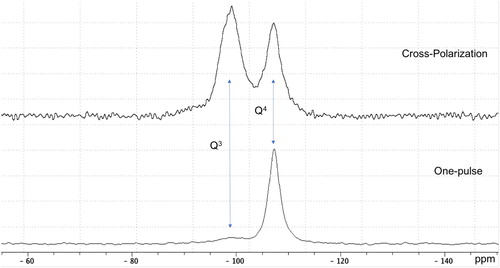
Figure 5. Left. 29Si NMR spectra permitting the assignment of the provenance of two archaeologic cherts: one found at Cova del Parco (Blue) coming from Buala (Green) and the second one found at Montlleó (Red) coming from Montsaunès (Orange). Right. Map showing the location of the different geological and archaeological samples described in this work.
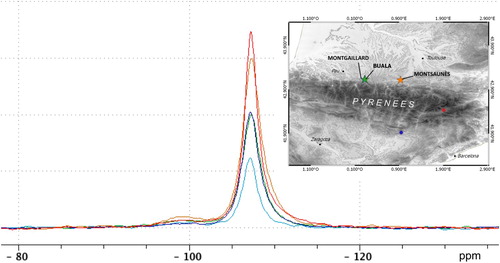
29Si spectra were also recorded for two archaeologic items found in different sites in the south Pyrenean Region (). The comparison of their 29Si spectra with those performed for three different deposits permits to propose the following provenances, Buala for the chert coming from Cova del Parco and Montsaunès for the chert found at Montlleó (, ).
27Al MAS-NMR experiments were also conducted on the different cherts samples. Despite the low aluminium abundancy in cherts (less than 1% Sànchez de la Torre et al. Citation2017a), 27Al is a nucleus easy to observe by NMR, its natural abundance being of 100%, its gyromagnetic ratio comparable to one of 13C and short relaxation times. Due to these favourable properties, 27Al MAS-NMR spectra were obtained in a reasonable time (close to 1 h, ). Interestingly, two resonances are observed: the main one ( 52–54 ppm, see ) assigned to a 4-coordinated Aluminosilicate (AlIV), such as AlO4 connected to SiO4 tetrahedra of Q4(4Si) type, and a minor resonance assigned to a 6-coordinated Al (AlVI) occurring at 4–5 ppm such as AlO6 (Guarino et al. Citation1997). The ability to distinguish octahedral and tetrahedral Al in inorganic compounds make possible the semi-quantitative estimate of their amount as shown in . The quadripolar nature of 27Al nuclei (spin 5/2) also requires the determination of the Chemical Shift Anisotropy (CSA) and the asymmetry parameter (η) that permit the determination of
. To ensure a better estimation of these parameters, spectra were also recorded at a spin rate of 3000 Hz (, top). All these values are reported in . First of all, the total area observed is representative of the content already measured for each sample using XRF as previously reported (Sànchez de la Torre et al. Citation2017b) (0.55% for Bula, vs. 0.35% for Montgaillard and Montsaunès). Another interesting measure is the AlIV/AlVI ratio that appears to be different in the Montsaunès sample (7.3) compared to the one observed for Buala or Montgaillard (1.7 and 1.8, respectively).
Figure 6. 27Al MAS-NMR spectra of MontSaunes Chert recorded at a 10KHz (bottom) or 3KHz (top) spinning rate. (*) represents the rotation side bands.
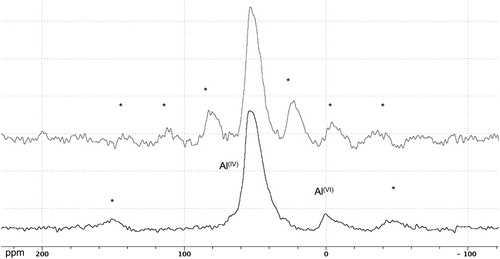
Table 3. 27Al NMR quantities. 
 , CSA and
, CSA and 
 were obtained by fitting the AlIV resonance using the software TOPSPIN 3.5 (Bruker).
were obtained by fitting the AlIV resonance using the software TOPSPIN 3.5 (Bruker).
As previously shown, some discriminant elements can be exploited to determine the geographic origin of archaeologic cherts such as the area signal of 29Si or even 27Al spectra combined with the AlIV/AlVI ratio. Using these different data, we are able to assign the chert found at Cova del Parco to the Buala deposit when the Montlleó one appears to come from the Montsaunès place.
Discussion
In the present work, we apply solid-state MAS-NMR spectroscopy for arch-aeometric purposes, notably to identify the provenance of archaeologic artefacts through two examples, Marbles and Cherts. The thread is the same, it consists of looking at the major component of the stone and inspecting the NMR response, which can be extremely sensitive to the chemical environment of the studied nucleus.
For marbles, the target was the calcite CaCO3, and the nucleus tracked the carbon 13C. In a previous work (Gutiérrez et al. Citation2019), we demonstrate how the 13C nuclide was sensitive to the presence of paramagnetic species such as Fe2O3, by the intensity of the calcite signal and to the defects of the calcite crystals in which calcium could be replaced by another atom. This property, which was applied to marbles coming from different quarries of the Mediterranean basin (Turkish, Greek, Italian, Spanish and French quarries), is presently extended to neighbouring quarries from the district of Saint-Béat. Four of them were chosen due to their location regarding the Garonne river: Marignac and the quarry of Lavigne are on the left bank, in the Mont Rié while Boutx and Château on the right bank, in the Cap du Mont (see ). The 13C NMR spectra recorded are significantly different and thus, they can be used as a help to discriminate between marbles coming from this same district, which is usually very difficult to achieve through the usual archaeometric methods applied to the study of marbles. The two archaeologic items tested were probably made of the same marble, and the comparison of their spectra with those of marbles from studied quarries suggests that they were coming from that of Saint-Béat Château.
Concerning cherts, we target both the main component SiO4 quartz-like structure – which represents up to 99% of the mineral content – using 29Si NMR and their aluminosilicate contents – less than 1% – using 27Al NMR, since this nuclide is recognized to be easy to observe, and permits the determination of Al(IV)/Al(VI) ratios (Jakobsen, Jakobsen, and Lindgreen Citation1988; Smith Citation1993). The 29Si spectra of the three geologic Pyrenean deposits studied in this work present significant differences notably in the peak area of the major component Q4, that should be used as a discriminant element for provenance purpose. This phenomenon is the consequence of differences in “spin–lattice” or T1 relaxation from one sample to another attributed to different contents of magnetic impurities such as transition metals or rare earth cations. 27Al spectra also present discriminant profiles: the total signal area, which reflects the aluminium-containing minerals and does not depend on the relaxation time since this nuclide is known to have short T1 and the distribution of the signal between two species Al(IV) and Al(VI). These discriminant NMR profiles served previous analyses for decision-making about the provenance of two archaeologic items, found in two different Pyrenean sites, Cova del Parco and Montlleó. In fact, previous studies demonstrated that the Cr, Sr and Th trace elements levels permit to discriminate the Montgaillard flysch and the Montsaunes cherts (Sànchez de la Torre et al. Citation2017b), however the comparative petrographic and geochemical characterization of the archaeological sample from Cova del Parco does not fit with one or the other geologic site. The discovery of another geological outcrop near Montgaillard, Buala (Sànchez de la Torre, Le Bourdonnec, and Gratuze Citation2019), and the analysis of these artefacts and the Buala site by Micro-PIXE (Sànchez de la Torre et al. Citation2019) to determine major, minor and trace elements in cherts demonstrated that this latter site can be distinguished using PCA graphs. However, some uncertainties still remain to attribute the provenance for the archaeologic chert tools. At this stage, 27Al and 29Si solid-state NMR can help to take a decision: with regards to the spectra profiles, we can propose that the artefact coming from Cova del Parco is made of Buala chert when the one of Montlléo, of Montsaunès demonstrating trans-Pyrenean human circulation on long distance associated to procurement strategies since the Magdalenian (13,700–18,800 BP).
In conclusion, solid-state NMR that is known to be useful for material characterization purpose can be also successfully used for provenance purposes. It supports the approaches commonly used, and helps for decision-making when the identification of the provenance could not be achieved by using them alone. Indeed, the different methods used to give information on the structure of the material under investigation according to different point of view: if NMR probes the ensemble of local environments around the nucleus observed in the material (C for marbles, Si or Al for cherts) whether it is crystalline or amorphous, powder X-ray Diffraction data will inform about the different crystalline components present and elementary analysis will track the content of secondary or trace elements. All these analyses combined with others (notably the isotopic ratio for marbles for which numerous data still exist (Gorgoni et al. Citation2002)) permit step by step to propose a provenance with confidence.
Acknowledgments
This project is part of (i) concerning marbles, the ROMAE project of the LaScArBx (programme funded by the ANR-N° ANR-10-LABX-52) and of a collaboration with the project HAR2015-65319-P (MINECO/FEDER) of the ICAC, Tarragona, Spain and (ii) concerning cherts, a Post-doctoral fellowship from the Initiative d’Excellence de l’Université de Bordeaux (M. Sánchez de la Torre). NMR analyses were performed at the CESAMO, ISM, Université de Bordeaux, Département Sciences et Technologie, and we want to thank the CESAMO team and especially Cybille Rossy for their help. We also want to thank A. Ziegle, curator of Roman antiquities at the Musée d’Aquitaine, for her precious help and Nathan McClenaghan for the English.
Disclosure statement
No potential conflict of interest was reported by the authors.
Notes on contributors
Dr Isabelle Pianet received her Ph.D. in Biochemistry at the University of Bordeaux (1990) and entered at the CNRS as an Ingénieure de Recherche (1991). After 25 years at the Institut des Sciences Moléculaires in Bordeaux where she managed the analytical chemistry department CESAMO, she joined the IRAMAT-CRP2A laboratory. Her research focuses on the development of new tools such as NMR for sourcing purpose and for the characterisation of archaeologic residues such as wine.
Dr Anna Gutiérrez Garcia-M. received her MA in Lithic and Ceramic Analysis for Archaeologists at the University of Southampton (2003) and her PhD in Archaeology at the Autonomous University of Barcelona (2007). She has developed her research at the Laboratory for the Study of Stones in Antiquity (LEMLA) at the UAB, the IRAMAT-CRP2A as Chaire Junior of the LaScArBx, and the Catalan Institute of Classical Archaeology (ICAC), where she is currently a Ramón y Cajal researcher and director of the Archaeometric Studies Unit.
Marie Claire Savin is currently preparing for his Ph.D. in Archaeometry between two Universities, Bordeaux Montaigne and Zaragoza. The theme of her research concerns the marble resources of the North of Spain, and their use/reuse during Antiquity and later.
Dr Pilar Lapuente Mercadal is a Lecturer in Petrology and Geochemistry at the University of Zaragoza, Department of Earth Sciences, where she received her Ph.D. in Geology in 1991. From October 1991 to December 1992, she got a postdoctoral fellowship to specialize in Archaeometry at diverse Institutions from U.K. In 1994, she received the award “young researchers of the Spanish Society of Mineralogy” for her contribution using TL (at the RLAHA of Oxford University), in the field of Mineralogy applied to architectural heritage. Her research is focused on Petrology and Geochemistry applied to Heritage and Archaeometry of lithic materials such as marbles, ceramics, pottery, building and decorative materials.
Dr Marta Sánchez de la Torre received her Ph.D. in Prehistory at the University of Barcelona (2015) and after this, she joined the IRAMAT-CRP2A as a postdoctoral researcher (funded by IdEx Bordeaux) between 2015 and 2017. In 2018 she joined the University of Zaragoza as a Juan de la Cierva postdoctoral researcher. Her research mostly focuses on the geochemical analysis of lithic raw materials from Palaeolithic periods. She is currently directing archaeological works at several Palaeolithic and Neolithic sites from the Pyrenean region as Parco Cave, Xicotó rockshelter and Montlleó open-air site.
Dr François-Xavier Le Bourdonnec is an Associate Professor in Archaeological Sciences at the Université Bordeaux Montaigne. Since 2002, his research has mainly focused on sourcing prehistoric lithic raw materials.
Additional information
Funding
Notes
1 Unpublished data from the analysis undertaken within the framework of the ROMAE project (LaScArBx n°ANR-10-LAB-52).
References
- Abragam, A. 1961. The Principles of Nuclear Magnetism. Oxford: Clarendon Press. Vol. 32, p. 614.
- Adams, S. J., G. E. Hawkes, and E. H. Curzon. 1991. “A Solid State 29Si Nuclear Magnetic Resonance Study of Opal and Other Hydrous Silicas.” American Mineralogist 76: 1863–1871.
- Baias, M., and B. Blümich. 2018. Nondestructive Testing of Objects from Cultural Heritage with NMR. Cham: Springer.
- Capitani, D., V. Di Tullio, and N. Proietti. 2012. “Nuclear Magnetic Resonance to Characterize and Monitor Cultural Heritage.” Progress in Nuclear Magnetic Resonance Spectroscopy 64: 29–69. doi: 10.1016/j.pnmrs.2011.11.001
- Capitani, D., and N. Proietti. 2015. “NMR in Cultural Heritage.” Magnetic Resonance in Chemistry 53 (1): 1. doi: 10.1002/mrc.4200
- Engelhardt, G. 1989. “Multinuclear Solid-State NMR in Silicate and Zeolite Chemistry.” TrAC Trends in Analytical Chemistry 8 (9): 343–347. doi: 10.1016/0165-9936(89)87043-8
- Goldman, M. 2001. “Advance in Magnetic Resonance, Formal Theory of Spin-Lattice Relaxation.” Journal of Magnetic Resonance 149: 160–187. doi: 10.1006/jmre.2000.2239
- Gorgoni, C., L. Lazzarini, P. Pallante, and B. Turi. 2002. “An Updated and Detailed Mineropetrographic and CO Stable Isotopic Reference Database for the Main Mediterranean Marbles Used in Antiquity.” In Proceedings of the Fifth International Conference of the ASMOSIA (Boston, June 1998), edited by J. J. Herrmann, N. Herz, and R. Newman, Vol. 5, 115–131. London: Archetype.
- Guarino, A. W. S., R. A. S. San Gil, H. Polivanov, and S. M. C. Menezes. 1997. “Characterization of a Brazilian Smectite by Solid State NMR and X-Ray Diffraction Techniques.” Journal of the Brazilian Chemical Society 8 (6): 581–586. doi: 10.1590/S0103-50531997000600004
- Gutiérrez, Garcia-M. A. 2011. “The Exploitation of Local Stone in Roman Times: the Case of North-Eastern Spain.” World Archaeology 43: 318–341. doi: 10.1080/00438243.2011.586201
- Gutiérrez, Garcia-M. A., H. Royo Plumed, S. González Soutelo, M.-C. Savin, P. Lapuente, and R. Chapoulie. 2016. “The Marble of O Incio (Galicia, Spain): Quarries and First Archaeometric Characterisation of a Material Used Since Roman Times.” ArchéoSciences 40: 103–177.
- Gutiérrez, Garcia-M. A., M. C. Savin, N. Cantin, S. Boudoumi, P. Lapuente, and I. Pianet. 2019. "NMR as a New Tool for Cultural Heritage Application: The Provenance of Ancient White Marbles.” Archeometry 61 (4): 795–808.
- Jakobsen, H. J., H. Jakobsen, and H. Lindgreen. 1988. “Solid State 27Al and 29Si MAS NMR Studies on Diagenesis of Mixed Layer Silicates in Oil Source Rocks.” Fuel 67: 727–730. doi: 10.1016/0016-2361(88)90306-7
- Lapuente Mercadal, M. P. 2014. “Archaeometry on Stones. Multi-Method Approach to Investigate Stone Provenance. Studied Cases From Roman Hispanic Marmora.” Archeometriai Műhely 3: 149–158.
- Mackenzie, K. J. D., and M. E. Smith. 2002. Multinuclear Solid-State NMR of Inorganic Materials. Amsterdam: Pergamon. Vol. 6, p 727.
- Oldfield, E., R. A. Kinsey, K. A. Smith, J. A. Nichols, and R. J. Kirpatrick. 1983. “High-Resolution NMR of Inorganic Solids. Influence of Magnetic Centers on Magic-Angle Sample-Spinning Lineshapes in Some Natural Aluminosilicates.” Journal of Magnetic Resonance 51: 325–329.
- Pianet, I., Garcia-M. A. Gutiérrez, M.-C. Savin, R. Chapoulie, M. P. Lapuente Mercadal, J. Trebosc, and P. Florian. “ On the Provenance of Dolomitic White Marbles: A Natural Abondance 43Ca Solid-state NMR Spectroscopy Study.” In ASMOSIA XII, Proceedings of the Conference, ASMOSIA, Ed. Izmir, Turquey, 2018.
- Royo Plumed, H. “ Mármoles de la Cordillera Pirenaica: afloramientos norpirenaicos y asociados al “Nappe des Marbres”. Caracterización y uso en época romana.” University of Zaragoza, Zaragoza, 2016.
- Royo Plumed, H., M. P. Lapuente Mercadal, J. A. Cuchi, M. Brilli, and M.-C. Savin. “ Updated Characterisation of White Saint-Béat Marble.” Discrimination Parameters from Classical Marbles. ASMOSIA XI, Interdisciplinary Studies on Ancient Stone, Proceedings of the XI International Conference of ASMOSIA 2018, 379–389.
- Royo Plumed, H., P. Lapuente Mercadal, E. Ros, M. Preite-Martinez, and J. A. Cuchi. “ Discriminating Criteria of Pyrenean Arties Marble (Aran Valley, Catalonia) from Saint-Béat Marbles: Evidence of Roman Use.” In [ASMOSIA X] Interdisciplinary Studies on Ancient Stone: ASMOSIA×: Proceedings of the Tenth International Conference of ASMOSIA, Association for the Study of Marble & Other Stones in Antiquity, Rome, 21–26 May 2012, Pensabene, P.; Gasparini, E., Eds. “L’Erma” di Bretschneider: Rome, Italie, 2015; pp 671–682.
- Sànchez de la Torre, M. 2015. “Las Sociedades Cazadoras-Recolectoras del Paleolítico Superior Final Pirenaico: Territorios Económicos y Sociales.” Monografies del SERP 11: 314.
- Sànchez de la Torre, M., A. Angyal, Z. Kertész, S. Dubernet, F.-X. Le Bourdonnec, E. Papp, Z. Szoboszlai, Z. Török, A. Csepregi, and Z. Szikszai. 2019. “Micro-PIXE Studies on Prehistoric Chert Tools: Elemental Mapping to Determine Paleolithic Lithic Procurement.” Archaeological and Anthropological Sciences 11: 2375–2383. doi: 10.1007/s12520-018-0668-9
- Sànchez de la Torre, M., F.-X. Le Bourdonnec, and B. Gratuze. 2019. “Reconsidering Prehistoric Chert Catchment Sources: New Data from the Central Pyrenees (Western Europe).” Archaeological and Anthropological Sciences 11 (3): 947–957. doi: 10.1007/s12520-017-0581-7
- Sànchez de la Torre, M., F.-X. Le Bourdonnec, S. Dubernet, B. Gratuze, X. Mangado, and J. M. Fullola. 2017a. “The Geochemical Characterization of Two Long Distance Chert Tracers by ED-XRF and LA-ICP-MS. Implications for Magdalenian Human Mobility in the Pyrénées (SW Europe).” STAR: Science & Technology of Archaeological Research 3 (2): 405–417. doi: 10.1080/20548923.2017.1370842
- Sànchez de la Torre, M., F.-X. Le Bourdonnec, B. Gratuze, R. Domingo, L. M. Garcia-Simon, C. Mazo, and P. Utrilla. 2017b. “Applying ED-XRF and LA-ICP-MS to Geochemically Characterize Chert. The Case of the Central-Eastern Pre-Pyrenean Lacustrine Cherts and Their Presence in the Magdalenian of NE Iberia.” Journal of Archaeological Science: Reports 13: 88–98. doi: 10.1016/j.jasrep.2017.03.037
- Smith, M. E. 1993. “Application of 27Al NMR Techniques to Structure Determination in Solids.” Applied Magnetic Resonance 4: 1–64. doi: 10.1007/BF03162555
- Stebbins, J. F., and X. Xue. 2014. “NMR Spectroscopy of Inorganic Earth Materials.” Reviews in Mineralogy and Geochemistry 78: 605–653. doi: 10.2138/rmg.2014.78.15
- Webb, G. A. 2018. Modern Magnetic Resonance. Archaeology. Cham: Springer.
